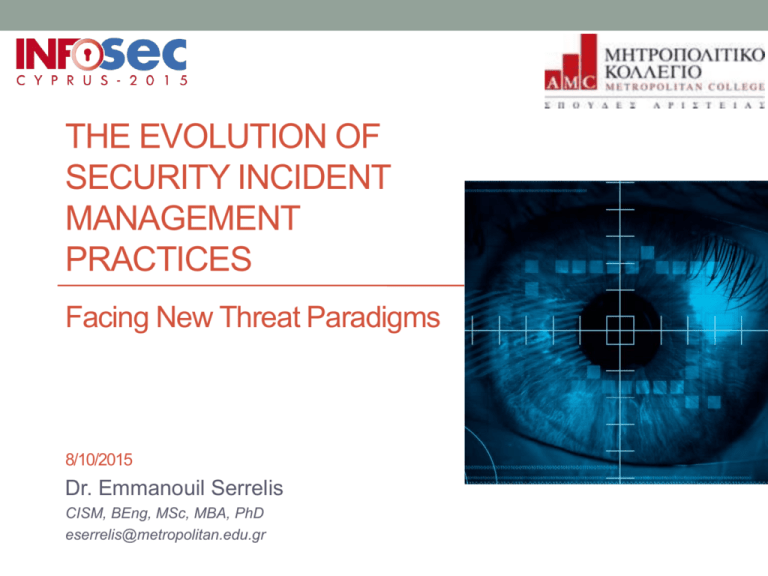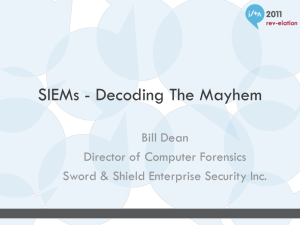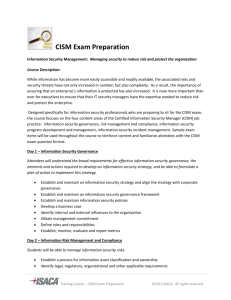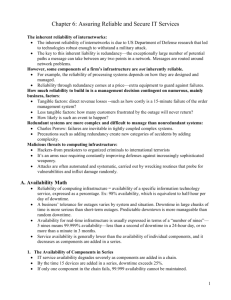I.T. Security: Protecting Your Key Corporate Assets
advertisement

THE EVOLUTION OF SECURITY INCIDENT MANAGEMENT PRACTICES Facing New Threat Paradigms 8/10/2015 Dr. Emmanouil Serrelis CISM, BEng, MSc, MBA, PhD eserrelis@metropolitan.edu.gr 2 The evolution of a soldier 3 Current attack surface 4 Current attack surface 5 New attack surface 6 New attack surface 7 New attack paradigms • Trust exploitation • Hackers Intelligence • Medium-neutral attacks (e.g. Cloud, O/S, IoT) • Industry-specific attacks (e.g. Pharma trojan) • Combination attacks (e.g. Bank Insider Fraud) • Unknown attacks • Are they really? The current answer: Incident Management 9 Incident management best practices • Define: What is an incident for you? • Develop workflows: What should you do in case of…? • Obtain resources: Who/what should be involved? • Train: What should you know beforehand? • Prepare Plan B: What if workflows fail? • Communicate: Who should be informed about what? • Integrate: Who are your business / technical liaisons? • Enrich knowledge: What should be added to your knowledge base? • Review and Report: What are the conclusions? • Evolve: How should the whole process be improved? 10 A new perspective: Drivers • Current research activity • Metropolitan College: Information Security and Computer Forensics research team • Current applications and services are protected through enterprise-wide mechanisms and processes, e.g. corporate SIEM solutions, SOC as a Managed service • Protection mechanisms are based on: • Integration capabilities of applications and services • Knowledge of applications and services internal structure and function 11 A new perspective: Principles • What if we start building apps and services ready to integrate to Open SOCs that would dynamically: • Indicate most risky vulnerable points • Indicate most risky suspicious actions • Indicate less risky countermeasures • Open SOCs could combine the collective knowledge of: • Corporate SIEM solutions • Intelligence networks • Security vulnerabilities and threat DBs • etc. 12 A new perspective: Development • Relevant efforts exist, e.g. Cisco OpenSOC • However, our design is build to : • include non-network data as well • accommodate confidentiality needs of sensitive service data • combine heterogeneous sources (e.g. anti-fraud and SIEM systems) • Integrate to app or a SOC middleware (as opposed to the SOC itself) • Find me later to talk more about it … :) Hold these thoughts… • Attacks change their pattern and techniques • The attack surface continues to increase • Focus on critical services and goods – not the medium • Act as in a “state of compromisation” – Stay alert • Invest on people’s awareness • Standardize and automate procedures • Introduce business-oriented Risk factor in incident monitoring • More on tomorrow's workshop “Production-Oriented Risk Management Techniques for Managing Cybercrime Threats” • Become active member of Community Intelligence Networks (e.g. CCS) THE EVOLUTION OF SECURITY INCIDENT MANAGEMENT PRACTICES Facing New Threat Paradigms Thank you! 8/10/2015 Dr. Emmanouil Serrelis CISM, BEng, MSc, MBA, PhD eserrelis@metropolitan.edu.gr











